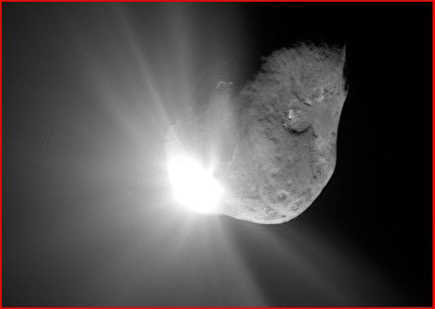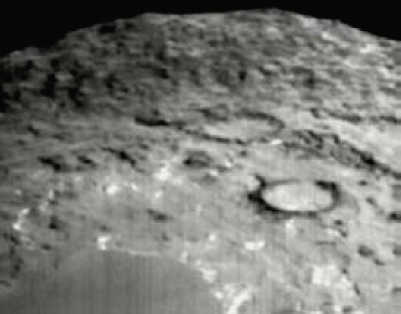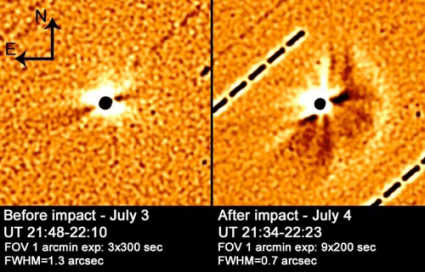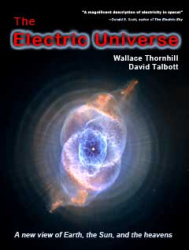|
|
Excerpts From The Electric Universe
Part 7
The following is one of a series of excerpts from The Electric Universe,
copyright © 2002, 2007 Wallace Thornhill and David Talbott and published by
Mikamar Publishing. Reproduced with the kind permission of the authors and publisher.
Presented by Dave Smith
|
|
|
|
May 15, 2010
|
|
|
If electric cometary theory needed any more support than we have seen
in this series, it was supplied when NASA slammed a copper projectile
into comet Tempel 1 on the Deep Impact mission. Whilst most scientists
were confronted with surprise after surprise, Wal Thornhill applied
Electric Universe theory to predict what would be observed. Although
his predictions were on public record before the event, they were met
with an eerie silence by the scientific community.
Page 114:
Deep Impact: The Smoking Gun
On July 4, 2005, one of the most watched events of the
space age occurred, when an 820 pound copper projectile,
fired from the Deep Impact spacecraft, struck the nucleus of
Comet Tempel 1. The following is a partial summary of
correct predictions for Deep Impact based on the electric
comet model. Many of these predictions were made as early
as October, 2001, and some on the eve of the event.133
|
|
|

Comet Tempel 1 67 seconds after it
obliterated Deep Impact's projectile.
Light from the collision saturated the
camera's detector. Scalloped craters can
be seen.
Image Credit: NASA/JPL-Caltech/UMD
[Click to enlarge]
|
|
|
• Energy of Explosion. “More energy will be released
than expected because of the electrical contributions of the
comet.” It is now well documented that the scale of the
energetic outburst stunned every scientist associated with
the project. These scientists knew the kinetics of impact,
and they all agreed that the explosion would be equivalent
to 4.8 tons of TNT. That's a good-sized bomb, but not even
close to what occurred.
• Advance flash. One of the authors, Wallace Thornhill, predicted
at least one flash from electric discharge prior to impact. From the
standard viewpoint, that is an absurd prediction when considering an
impactor hitting a body at 37,000 km per hour in 'empty' space. But
here is NASA investigator Peter Schultz's description of the event:
“What you see is something really surprising. First, there is a small
flash, then there's a delay, then there's a big flash and the whole thing
breaks loose.”
• Missing Water. “An abundance of water on or below the
surface of the nucleus (the underlying assumption of the 'dirty
snowball' hypothesis) is unlikely.” “It's pretty clear that this event
did not produce a gusher,” said SWAS principal investigator Gary
Melnick of the Harvard-Smithsonian Center for Astrophysics. “The
more optimistic predictions for water output from the impact haven't
materialized….” (See information panel p. 94.)
• Sharp Surface Relief. “The model predicts a sculpted surface,
distinguished by sharply defined craters, valleys, mesas, and
ridges.” All of the expected features are present, and astronomers
cannot agree on the cause, though all agree that Tempel 1 does not
look like a melting snowball.
|
|
|

The white areas on comet Tempel 1 are
the cometary equivalent to "St. Elmo's
fire" – coronal glow discharges sometimes
observed dancing on high points
in lightning storms on Earth. Similar, but
more powerful arcs on Jupiter's moon
Io produced 'whiteouts' that overloaded
the Galileo probe camera and surprised
the investigators.
Image Credit: NASA/JPL--Caltech/UMD
[Click to enlarge]
|
|
|
• Surface Arcing. This prediction is, of course, inherent in the
electric model. The highest resolution photographs of Tempel 1,
taken by the impactor, show numerous unresolved and unexplained
white spots (left), most located where the electrical hypothesis would
put them—on the rims of craters and on the wall of cliffs rising
above flat valley floors. Electrical etching continually expands valley
floors by eating away at the sharp edges of surrounding cliffs.
Page 115:
|
|
|

[Click to enlarge]
|
|
|
• New Jets. Thornhill was the only one to have
anticipated a shift in the arrangement, number, and
the intensities of the jets away from the impact site.
The 2.5-meter NOT telescope of the El Roque de
los Muchachos observatory at La Palma, Spain
released images just before impact and 15 hours
after impact. The observatory report states, “New
jets appeared after the impact.” No explanation has
been given.
• Electrostatic Cleaning. Prediction: “electrical
arcing and 'electrostatic cleaning' will clean the
nucleus' surface, leaving little or no dust or debris
on it.” The surface of Tempel 1 contrasts with the
surface of the asteroid Itokawa (see following page). The asteroid
appears to have attracted considerable surface debris
electrostatically. We suggested an active comet would do the reverse.
Removal of surface debris would then be analogous to the
'miraculous' cleaning of the solar panels of the Mars rover
Opportunity.134
Deep Impact and Missing Water
Through much of the space age, comet investigators have been
hoping to confirm the presence of water on comet nuclei. But it seems
that comets have been unwilling to cooperate.
By the time of Deep Impact comet theory had fragmented into
contradictory hypotheses, due in part to the lack of detectable water on
cometary surfaces—a prerequisite of comet theory.
In 1986, visits to comet Halley by the European Giotto and Russian
Vega probes failed to locate surface water and raised the distinct
possibility that the nucleus might not be ejecting water into space.
In January 2004, the Stardust spacecraft passed by Comet Wild 2,
identifying a dozen jets of material exploding from the nucleus. The
craft plowed through surprisingly dense pockets of dust swirling
around the comet, but investigators were astonished that they could not
find even a trace of water on the surface, despite the energetic activity.
According to a NASA report, the flyby of Comet Borrelly by the
Deep Space 1 craft in 2001 “detected no frozen water on its surface.”
When comet Shoemaker-Levy 9 broke apart, astronomers
reasoned that the fractured nucleus would expose fresh ices that would
sublimate furiously. So several ground-based telescopes and the
Hubble Space Telescope trained their spectroscopes on the tails of the
fragments of SL-9, looking for traces of volatile gases. None of the
gases was found.
Page 116:
When Comet Linear disintegrated in front of their eyes,
astronomers were not just shocked by the event (a comet exploding
many millions of kilometers from the Sun), they were astonished to
find virtually no water in the immediate debris.
The absence of detectable water on comet nuclei had produced a
crisis in comet theory well before Deep Impact. And that mission did
nothing to rescue the theory. The Harvard-Smithsonian Center for
Astrophysics summarized the early findings with the headline, “Deep
Impact Was a Dust-up, Not a Gusher.” Smithsonian astronomers
reported “only weak emission from water vapor and a host of other
gases that were expected to erupt from the impact site. The most
conspicuous feature of the blast was brightening due to sunlight
scattered by the ejected dust.”
The results of the Deep Impact mission were published in the
journal Science. Team members reported that they found only a
smattering of water ice on the surface of Tempel 1. To account for the
water supposedly emitted into the coma of Tempel 1, the investigators
needed 200 times more exposed water ice than they could find. The
electrical alternative faces no such dilemma (see information panel p.
94).
|
|
|
References:
133
See: www.thunderbolts.info/tpod/2005/arch05/050704predictions.htm
134
www.thunderbolts.info/tpod/2005/arch05/050531roverclean.htm
|
|
|
|
|
Permalink to this article.
Email this article to a friend
Public comment may be made on this article on the
Thunderbolts Forum/Thunderblogs (free membership required).
To read more from Wal Thornhill please visit:
holoscience.com
|
|
|
|
|
|
|
|
|
YouTube video, first glimpses of Episode Two in the "Symbols of an Alien Sky"
series.
|
|
|
|
|
|
|
Three ebooks in the Universe Electric series are
now available. Consistently
praised for easily understandable text and exquisite graphics.
|
|
|
|
|
|
|
|










